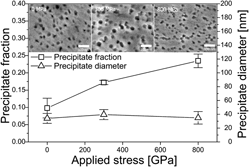Crossref Citations
This article has been cited by the following publications. This list is generated based on data provided by
Crossref.
Kim, Yong-Jae
Yoo, Byung-Gil
Choi, In-Chul
Seok, Moo-Young
Kim, Ju-Young
Ohmura, Takahito
and
Jang, Jae-il
2012.
Martensitic phase transformation and pop-in in compression of austenitic steel nanoplates observed in situ by transmission electron microscopy.
Materials Letters,
Vol. 75,
Issue. ,
p.
107.
Zhao, Yakai
Choi, In-Chul
Kim, Yong-Jae
and
Jang, Jae-il
2014.
On the nanomechanical characteristics of thermally-treated alloy 690: Grain boundaries versus grain interior.
Journal of Alloys and Compounds,
Vol. 582,
Issue. ,
p.
141.
Yan, Chong
Zhengdong, Liu
Godfrey, Andy
Wei, Liu
and
Yuqing, Weng
2014.
Microstructure evolution and mechanical properties of Inconel 740H during aging at 750 °C.
Materials Science and Engineering: A,
Vol. 589,
Issue. ,
p.
153.
Abbasi, Majid
Kim, Byung-Kyu
Kim, Dong-Ik
and
Jung, Woo-Sang
2016.
Effects of surface deformation on the oxidation behavior of INCONEL 740 superalloy in humid air.
Journal of Alloys and Compounds,
Vol. 683,
Issue. ,
p.
212.
You, Xiaogang
Tan, Yi
You, Qifan
Shi, Shuang
Li, Jiayan
Ye, Fei
and
Wei, Xin
2016.
Preparation of Inconel 740 superalloy by electron beam smelting.
Journal of Alloys and Compounds,
Vol. 676,
Issue. ,
p.
202.
Tan, Yi
You, Xiaogang
You, Qifan
Li, Jiayan
Shi, Shuang
and
Li, Pengting
2016.
Microstructure and deformation behavior of nickel based superalloy Inconel 740 prepared by electron beam smelting.
Materials Characterization,
Vol. 114,
Issue. ,
p.
267.
Liu, Wen
Lu, Fenggui
Tang, Xinhua
Yang, Renjie
and
Cui, Haichao
2016.
The microstructure evolution and element segregation of Inconel 617 alloy tungsten inert gas welded joint.
Journal of Materials Research,
Vol. 31,
Issue. 4,
p.
435.
Wang, Chang Shuai
Guo, Yong An
Guo, Jian Ting
and
Zhou, Lan Zhang
2016.
Gamma prime stability and its influence on tensile behavior of a wrought superalloy with different Fe contents.
Journal of Materials Research,
Vol. 31,
Issue. 9,
p.
1361.
Abbasi, Majid
Kim, Dong-Ik
Shim, Jae-Hyeok
and
Jung, Woo-Sang
2016.
Effects of alloyed aluminum and titanium on the oxidation behavior of INCONEL 740 superalloy.
Journal of Alloys and Compounds,
Vol. 658,
Issue. ,
p.
210.
Tian, Zhong-liang
Jiang, Sen-bao
Chen, Zheng-zong
Bao, Han-sheng
and
Liu, Zheng-dong
2017.
Microstructural evolution and mechanical properties of a new Ni-based heat-resistant alloy during aging at 750 °C.
Journal of Iron and Steel Research International,
Vol. 24,
Issue. 5,
p.
513.
You, Xiaogang
Tan, Yi
Shi, Shuang
Yang, Jenn-Ming
Wang, Yinong
Li, Jiayan
and
You, Qifan
2017.
Effect of solution heat treatment on the precipitation behavior and strengthening mechanisms of electron beam smelted Inconel 718 superalloy.
Materials Science and Engineering: A,
Vol. 689,
Issue. ,
p.
257.
You, Xiaogang
Tan, Yi
Wu, Chang
You, Qifan
Zhao, Longhai
and
Li, Jiayan
2018.
The Precipitation Behavior and Hot Deformation Characteristics of Electron Beam Smelted Inconel 740 Superalloy.
Journal of Materials Engineering and Performance,
Vol. 27,
Issue. 4,
p.
1580.
Liu, Dexue
Cui, Maomao
Wang, Wenxu
Nan, Hongqiang
Cai, Haopeng
Xue, Hongdi
Jia, Zhi
and
Li, Qinglin
2019.
Phase Transformation Strengthening of Hot Extruded Inconel 625 under High-temperature Load Environment.
Journal of Wuhan University of Technology-Mater. Sci. Ed.,
Vol. 34,
Issue. 6,
p.
1297.
Wu, Yunsheng
Liu, Zhuang
Qin, Xuezhi
Wang, Changshuai
and
Zhou, Lanzhang
2019.
Effect of initial state on hot deformation and dynamic recrystallization of Ni-Fe based alloy GH984G for steam boiler applications.
Journal of Alloys and Compounds,
Vol. 795,
Issue. ,
p.
370.
Han, Ke
Wang, Houqin
Peng, Fei
Zhang, Binggang
and
Guo, Licheng
2020.
Effect of thermal compensation treatment on the microstructure and mechanical properties of IN738LC joint by electron beam welding.
Journal of Manufacturing Processes,
Vol. 58,
Issue. ,
p.
536.
Wang, Houqin
Han, Ke
Peng, Fei
and
Zhang, Binggang
2021.
Strain-age cracking in vacuum electron beam welded IN738LC alloy during post-weld heat treatment.
Vacuum,
Vol. 194,
Issue. ,
p.
110588.
WANG, Kai-meng
JING, Hong-yang
XU, Lian-yong
ZHAO, Lei
HAN, Yong-dian
LI, Hai-zhou
and
SONG, Kai
2021.
Microstructure evolution of 55Ni−23Cr−13Co nickel-based superalloy during high-temperature cyclic deformation.
Transactions of Nonferrous Metals Society of China,
Vol. 31,
Issue. 11,
p.
3452.
Xu, Hui
Li, Yugui
Li, Huaying
Wang, Jinbin
Liu, Guangming
and
Song, Yaohui
2022.
Constitutive Equation and Characterization of the Nickel-Based Alloy 825.
Metals,
Vol. 12,
Issue. 9,
p.
1496.
Chu, Dong-Ju
Park, Chanhee
Lee, Joonho
and
Jung, Woo-Sang
2023.
Effect of Ti/Al Ratio on Precipitation Behavior during Aging of Ni-Cr-Co-Based Superalloys.
Metals,
Vol. 13,
Issue. 12,
p.
1959.
Kim, Kyu-Sik
Kang, Tae-Hoon
and
Lee, Kee-Ahn
2023.
Influence of Post‐Heat Treatments on the Microstructure, Mechanical Responses of IN738LC Superalloy Manufactured via Laser Powder Bed Fusion.
Advanced Engineering Materials,
Vol. 25,
Issue. 3,
